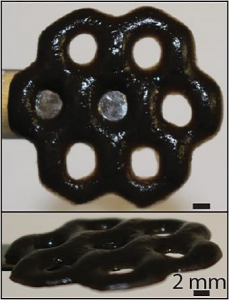While seaweed-derived alginate is already used in biomedical applications, hydrogels made from this material are not very strong.
“One limiting factor in the use of alginate hydrogels is that they’re very fragile — they tend to fall apart under mechanical load or in low salt solutions. What we showed is by including graphene oxide nanosheets, we can make these structures much more robust,” explained research leader Thomas Valentin, a PhD student in Brown’s School of Engineering, in a university news release.The 3D printing method used to make the material enables the creation of intricate structures like this one, which mimics the atomic lattice of graphene. [Image: Wong Lab, Brown University]
Using carbon-based graphene to reinforce the material makes it more robust and durable, so it can be used to help design additional smart materials that respond to external stimuli – making it perfect for use in other applications, such as marine and environmental. The use of stereolithography makes it possible to create stiff, intricate alginate-GO composite structures that are far more fracture resistant than alginate is on its own.
This ability to change the material’s stiffness also makes it a good fit for applications in dynamic cell cultures.
Valentin explained, “You could imagine a scenario where you can image living cells in a stiff environment and then immediately change to a softer environment to see how the same cells might respond.”
 Ionic bonds linking the sodium alginate polymers cause the material to dynamically respond to its environment: these bonds are strong enough to keep the material together, but certain chemical treatments can break them apart. The researchers proved this ionic crosslinking in previous experiments, and it can be used to create alginate materials that will rapidly degrade on demand once a chemical treatment “sweeps away ions from the material’s internal structure.”
Ionic bonds linking the sodium alginate polymers cause the material to dynamically respond to its environment: these bonds are strong enough to keep the material together, but certain chemical treatments can break them apart. The researchers proved this ionic crosslinking in previous experiments, and it can be used to create alginate materials that will rapidly degrade on demand once a chemical treatment “sweeps away ions from the material’s internal structure.”
Once the material has been treated with the chemical that removes its ions, it will swell up and become softer; only after bathing in ionic salts will the ions be restored to make the material stiff again. The researchers found that just by changing up the material’s external ionic environment, they could tune its stiffness over a factor of 500.
According to Ian Y. Wong, an assistant professor of engineering at Brown, graphene oxide can actually change the mechanical properties of alginate structures, which means that the team’s new composite material can be made to be much more resistant to failure caused by cracking. This made it possible to 3D print stiff structures with overhanging parts, which alginate by itself could not do.
“The addition of graphene oxide stabilizes the alginate hydrogel with hydrogen bonding. We think the fracture resistance is due to cracks having to detour around the interspersed graphene sheets, rather than being able to break right though homogeneous alginate,” Wong explained.
Wong explained, “These composite materials could be used as a sensor in the ocean that can keep taking readings during an oil spill, or as an antifouling coating that helps to keep ship hulls clean.”
The researchers will continue their work with their smart graphene oxide-seaweed hybrid material, including searching for ways to optimize its properties, efficiently mass produce it, and find new uses.
Co-authors of the paper are Valentin, Alexander K. Landauer, Luke C. Morales, Eric M. DuBois, Shashank Shukla, Muchun Liu, and Lauren H. Stephens of Brown University, as well as Christian Franck from the University of Wisconsin and Po-Yen Chen with the National University of Singapore.
Discuss this research and other 3D printing topics at 3DPrintBoard.com or share your thoughts in the comments below.
[Source: Design News]Subscribe to Our Email Newsletter
Stay up-to-date on all the latest news from the 3D printing industry and receive information and offers from third party vendors.
Print Services
Upload your 3D Models and get them printed quickly and efficiently.
You May Also Like
Johns Hopkins University Researchers Develop HyFAM Technology
Two scientists from Johns Hopkins University, Nathan C. Brown and Jochen Mueller, have developed a hybrid manufacturing technology they call HyFam, or Hybrid Formative Additive Manufacturing. Their work on this technology...
3D Printing G-Code Gets an Upgrade: T-Code
Good old G-Code still manages many 3D printers, great and small. Just like the STL, it’s a standard that enables collaboration while also holding the additive manufacturing (AM) industry back....
AM Rewind: The Biggest News and Trends of 2024
After a sluggish 2023, driven by persistent inflation and geopolitical tensions, 2024 has seen some recovery. Economic growth climbed from about 2.8 percent in 2023 to a modest 3.2 percent...
Metal Wire 3D Printer OEM ValCUN Announces Plans for 2025 Expansion
ValCUN, a Belgian original equipment manufacturer (OEM) of wire-based metal additive manufacturing (AM) hardware, has announced that the company has entered the next phase of its growth trajectory, making key...




































